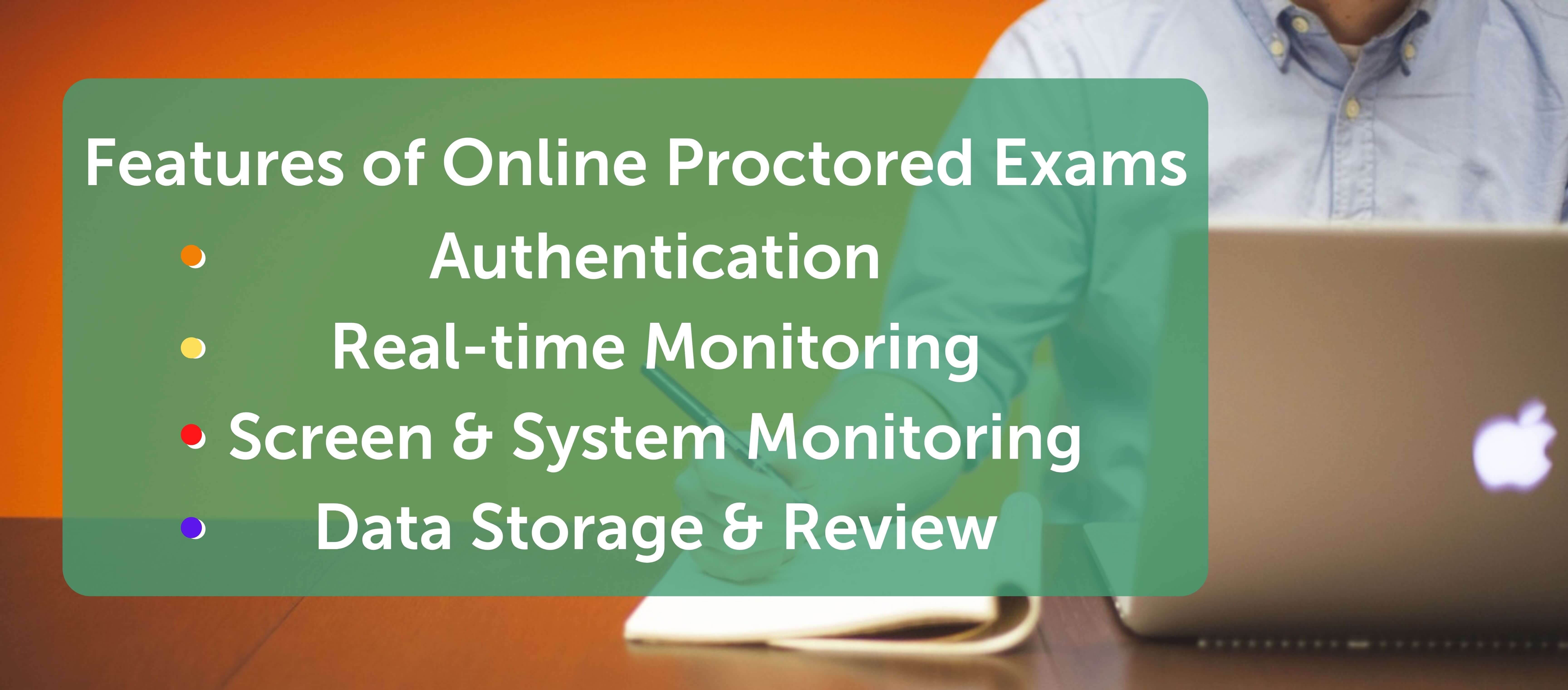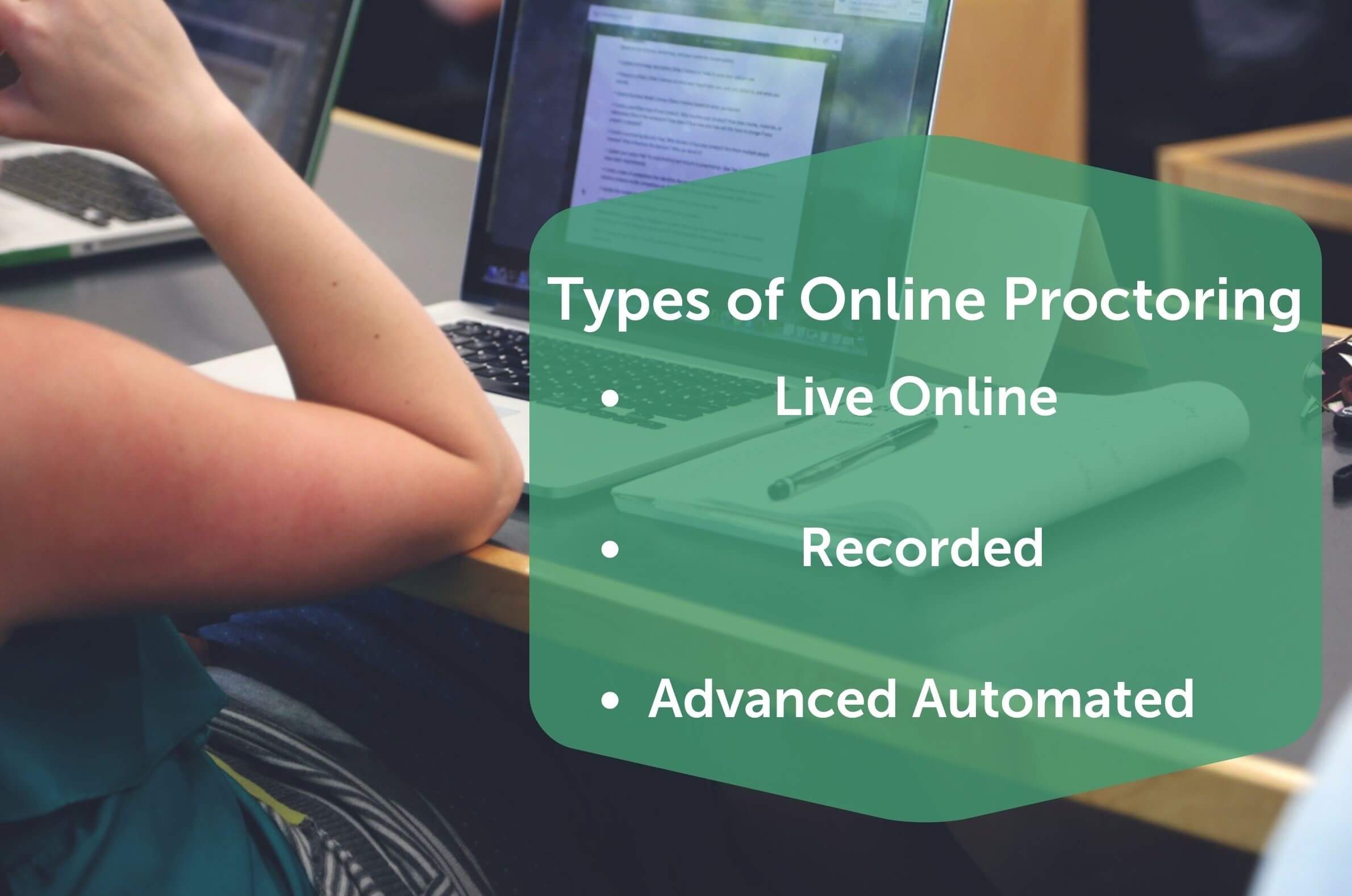Online proctored exams are remotely supervised timed exams that use monitoring software and video streaming to prevent and detect suspicious activity. As such, an online proctored exam is like any exam but with an online infrastructure.
How Does Online Proctored Exam Software Work?
Cloud-based systems drive the infrastructure of online proctored exams. The software validates the examinee’s identity before the exams start, and then tracks student activity. Using AI, the software then monitors and analyzes students’ computer screens, webcams, and microphones.
Features of Online Proctored Exam

Authentication
The software begins with authentication. It checks examinees’ identities and monitors suspicious behavior by ensuring students are sharing a screen with video and audio, making impersonation improbable. After proctors have authenticated the examinees’ identities, tests can commence.
Real-time Monitoring
The next step is monitoring students while they take exams. Proctoring algorithms monitor students and flag suspicious behaviors. Scenarios that are flagged include the presence of another person in the exam room, a student’s face out of the frame, distracted movements, and unauthorized devices. It is up to the discretion of the proctor to determine the activities that count as cheating.
Screen and System Monitoring
Remote proctors can monitor a student’s on-screen activity. Proctoring software uses anti-cheating solutions such as customized browser settings that prevent digital/on-screen cheating. Such browser-restrictions operate on full screen, preventing students from changing windows or accessing unauthorized applications. Students cannot open tabs/incognito tabs/windows. The proctoring software also blocks copying and pasting and automatically closes unwarranted browser tabs.
Data Storage and Review
The exam software stores the audio and video recordings on the cloud for authorities to review. This reduces the chance of candidates cheating as the software records all activities for later inspection. It also provides an extra layer to the monitoring system. It also reduces the chances of false positives. Data storage also reduces workforce requirement to monitor the exam as proctors can later inspect the recordings in leisure, as opposed to Live proctoring where cases like extended examination duration might require more than one proctor.
Types of Online Proctoring
 Live Online Proctored Exam
Live Online Proctored Exam
Live online proctoring monitors student activities via audio, video, and screen sharing features in real-time. Remote proctors need to be present during the duration of the exam to ensure authentication. If a proctor sees a student cheating, he or she can immediately take action or disqualify the student.
Recorded Proctoring
Recorded proctoring does not require human proctors as the software automatically records students’ audio, visuals, and screen in real-time. Proctors can review the recording at any time to check for suspicious activities.
Advanced Automated Proctoring
This type of proctoring is AI-enabled. Schools and institutions can conduct automated proctored exams without human proctors. There are minimal chances of error as AI detects suspicious activity with greater accuracy than humans, making it the most advanced type of online remote proctoring.
Components of Online Proctored Exam
Authentication
Authentication is the first step before an exam starts. Students need to validate their identity by using biometrics or identity cards and facial recognition technology. Students can register and take the exam after they clear this step.
Secure Browsing
When a student browses from the test window or tries to open a window, the secure browser feature stops the test. It blocks the screen of the student, as well as functions such as copy-pasting and restricted keys like Alt+Tab-. The software also detects if a student has synced their device. After detection, it will not let the exam start or terminate the exam immediately and log the candidate out of the software.
Proctoring
While an exam is in progress, the software checks for unwarranted activities. AI-based facial recognition and detection checks continuously scan and give alerts or warnings when it detects anomalies, while the remote proctor monitors the candidates through Live video and audio streaming.
Report Generation
A comprehensive report and analytics provide evidence to prove instances of cheating or unfair activities. Analytics automatically mark students who generated a high number of alerts. Examiners can then use video and audio playback to verify these occurrences.
Both proctors and students receive reports which include students’ performance, and in most cases, a percentage, percentile, and sectional summary.
Benefits of Online Proctored Exam
- Remote eLearning: Online proctoring solutions enable candidates to enroll from anywhere
- Evidence: Cheating attempts are recorded and logged with timestamps and can be presented as evidence
- Non-restrictive: The number of students taking an exam is not limited by space or distance. Examiners can scale with minimal manual intervention
- Continuous Monitoring: AI engines and real-time video streaming guarantee the entire exam is monitored and recorded
- Convenient: Online proctoring can be done from any location at any time
- Cost-effective: Institutions can conduct online proctored exams while saving on transportation, accommodation, and utility costs
- Efficient: Online proctored exams are time-saving, from registration to result-declaration. Administrators eliminate the logistical hurdles of printing, transportation, and manual data entry
Online proctored exams are a major part of the digital shift education is undergoing. With a rise in eLearning, online proctoring software offers a way to conduct secure online exams. Remote exams have helped extend accessibility across different areas. If you would like to read about the pros and cons of online learning, you can check our previous blog: 5 Advantages and Disadvantages of Online Learning.

